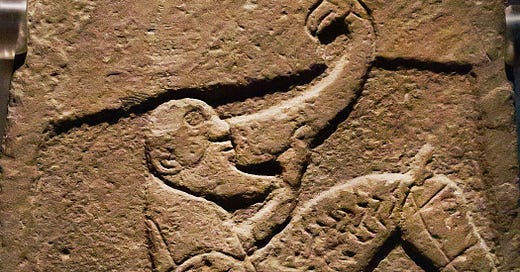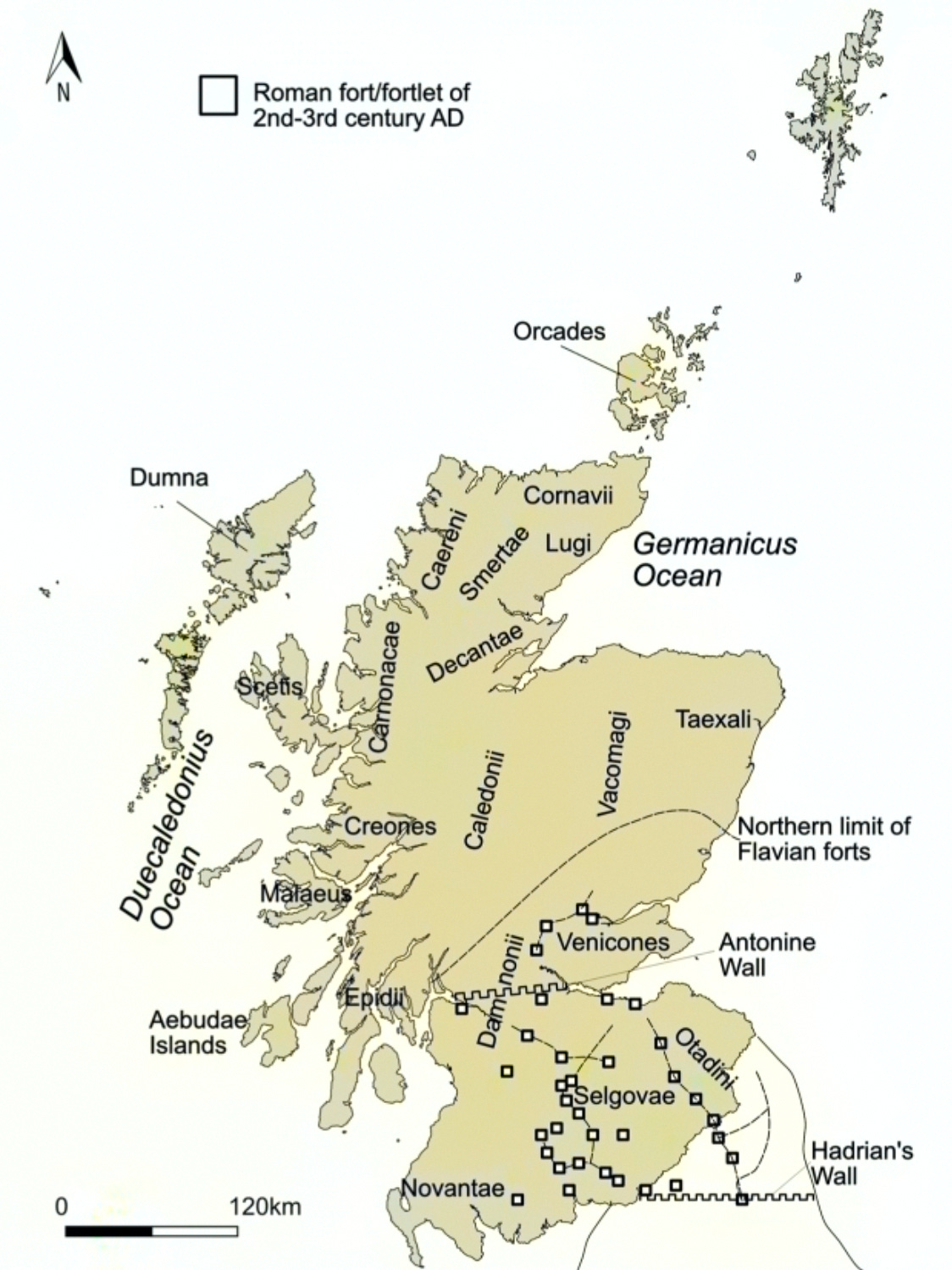The Rise of the Picts: Scotland's Native Tribes
Ancient Roman scholars referred to inhabitants of northern Britain as the Picts. But who were these mysterious warlike tribes?
A Pictish stone from Bullion, Angus, shows a bearded warrior on horseback holding a huge drinking horn with a large bird-headed mount at its tip, National Museum of Scotland
Little is known about the prehistoric inhabitants of Britain and Ireland prior to the arrival of the then-Roman general Julius Caesar. Between 55 and 54 BCE, he led the first incursions into what is now southeast England. By 43 CE, the Roman Empire had successfully conquered Southern Britain, establishing a province they named Britannia, and with this, we began to receive numerous in-depth accounts of the native groups with whom the Romans had come into contact. But these sources weren’t the oldest. Centuries prior, various Greek explorers and scholars, such as Herodotus, Pytheas, and Ptolemy of Alexandria, wrote about the mysterious Pretani, who appear to have inhabited the islands for thousands of years.
Pytheas was a Greek geographer and explorer from Massalia (modern-day Marseille, France) who supposedly embarked on a significant voyage to Northern Europe around 325 BC. During his travels, he ventured to the British Isles and later wrote a book about his experience. While no original copies remain intact, references to the work from later Greek historians such as Strabo and Diodorus Siculus claim Pytheas called the British Isles, including Ireland, “Pretanikai Nesoi,” or the Islands of the Pretani. Diodorus Siculus, writing in the 1st century BCE, also called the island of Britain Pretannia and its inhabitants the Pretanni.
Several centuries later, the highly educated Ptolemy of Alexandria, an Egyptian astronomer, mathematician, and geographer of Greek descent, wrote his famous work, Geographia. This comprised an extensive atlas that mapped the known world, shedding valuable insight into the Iron Age inhabitants of Britain and Ireland. Modern academics propose Ptolemy’s map was based on source material that predated the Roman infiltration of the British Isles, as he appears to have used Greek renditions of Celtic names for physical landmarks and the names of various tribes. In his writings, Ptolemy also used the name Pretanikai Nesoi to collectively refer to Britain and Ireland while giving the islands individual names Albion and Iouernia.
According to the revered Welsh historian John Rhys, the medieval Welsh or Brythonic term Ynys Prydin refers to the island of Britain and is related to the Pretanikai used by the Greeks. In fact, it appears the latter is a Greek rendition of the original Celtic word Pretani, a name that designates both the islands and the tribes as a whole. Therefore, many scholars, historians, and archaeologists have proposed that the term Pretani is the oldest name we can apply to the native inhabitants of pre-Roman Britain and Ireland.
The Tribes of the Pretani: Ancestors of the Picts
Population groups, oceans, and selected islands in Ptolemy’s Geography (140-50 AD) and Roman Fortifications of the 2nd and 3rd centuries
Ptolemy’s Geographia gives us our first look at the names of individual tribes living in Iron-Age Britain, whom we might loosely group together as the Pretani. When Rome later infiltrated the Isles, many of the Pretani residing in the south migrated to the northern and western regions. However, those who remained behind in the South were slowly pacified and eventually Romanized.
During the early years of the Roman province of Britannia, the most dominant of these Prettanic tribes in the north were the Lugi, Epidii, Caerini, Creeones, Smertae, Decante, Vacomagi, Carnonacae, Selgovae, Votadini, and the most famous of all, the feared Caledonii. The Caledonii tribe posed the greatest threat to Britannia. Eventually, they managed to unify many of the other tribes into a confederacy in preparation to push back the soon-to-be-advancing Roman forces. By 78 CE, Rome had essentially subjugated the entire southern population of the Isles. With Britannia’s governor, Gnaeus Julius Agricola, leading the movement, Roman soldiers made their way north toward the unruly tribes. However, the Romans couldn’t manipulate the tribes as they did in the south, so a full-scale invasion would be necessary to bring the northern territory under their dominion.
This conflict would culminate with the battle of Mons Graupius in 83 CE. According to the writings of Agricola’s stepson, Tacitus, the Roman army crushed the resistance led by the Caledonians. Yet, the Romans failed to hold onto the northern territories, ultimately leading to the construction of Hadrian’s Wall in 122 CE. The enormous structure stretched for over seventy miles, separating the Roman province from the northern lands, which would soon become known as Pictland. Two decades later, a second wall was built. Antonine’s Wall sat one hundred miles further north than Hadrian’s, aiming to extend the Roman territory further north. The righteous and hardened warriors who lived beyond this wall would soon come to be known as the Picti to Latin writers across their vast Empire.
The first mention of a group known as the ‘Picti’ was recorded two centuries after the battle of Mons Graupius. A Roman-era writer, Eumenius, referred to savage tribes and half-naked barbarians known as Picts who lived beyond the northernmost of Britannia’s boundaries in 297 CE. Scholars have long speculated upon the original meaning of this name. Some historians believe the name ‘picti’ means ‘painted ones’ in Latin, as the indigenous tribes are said to have covered themselves in blue tattoos. Others surmise it was related to a native word, ‘Pecht,’ used by the tribes of Scotland to refer to their ancestors. Nonetheless, it’s generally considered the Picts and their predecessors had formed several confederations that inhabited and controlled Northern Scotland from around 79 until 843 CE. No matter the individual origins and possible ethnic groups that the Romans grouped together as Picts, it was given to all people living above the northern walls.
In conclusion, historians generally agree that the word ‘Pict,’ used frequently by various scholars from the fourth to tenth centuries, was nothing more than a Latinized name for the indigenous peoples of Pretani. However, some have gone as far as to suggest that the name ‘Pict’ was solely reserved for the native people of Britain who had moved north of the Great Walls and took no part in Roman customs. In contrast, the name Briton refers to any tribe that had been Romanised. Nonetheless, both the Picts and the Romanised Britons should be considered descendants of the Pretani, which in Q-Celtic or Gaeilge, is Cruithne.
Sources:
1 - Ptolemy's Map of Ireland, Goddard H. Orpen (The Journal of the Royal Society of Antiquaries of Ireland, 1894)
2 - The Name 'Picti' Revisited, George Broderick (Journal for Scottish Name Studies, 2015)
3 - The Extraordinary Voyage of Pytheas the Greek, Barry Cunliffe, (2002)





Thanks for sharing this
I think they were into tattoos